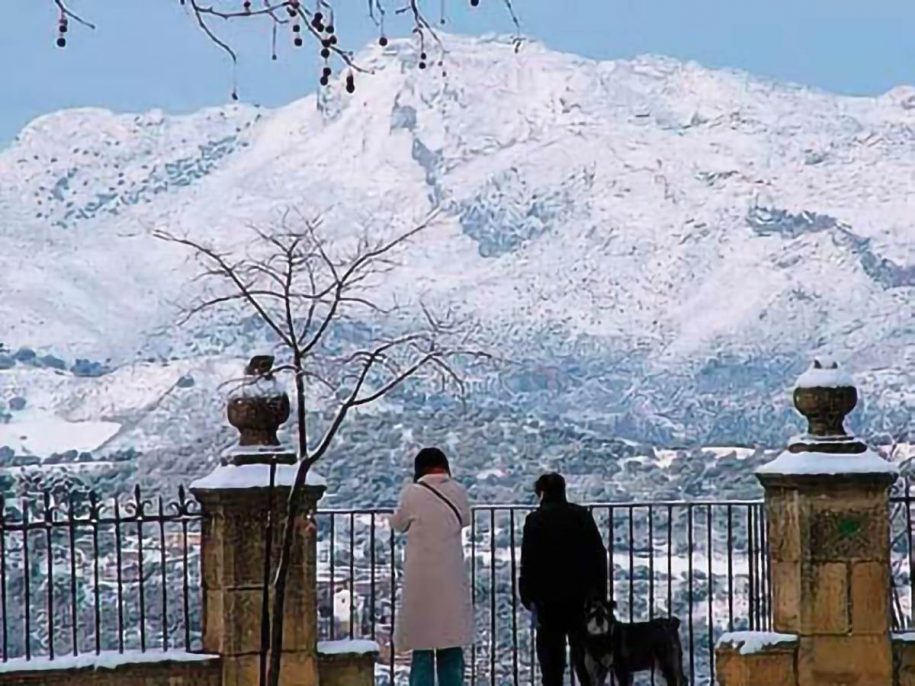The Enlightenment, from the end of the 18th century and during the 19th century, tried to introduce Nature into the urban perimeter. In this spirit, the origin of the Alameda del Tajo also coincides with the important urban modifications in the city of Ronda at the end of the 18th century.
The then Corregidor of the city, the Marqués de Pejas, was the first who planned to establish a good walk in the Market, for this he pointed to a spacious square where he came to plant some trees. It was an esplanade that was in front of the church and convent of the Mercedarios, where the appropriate works and the planting of trees and some garden plants began. They were finished, since there was an interruption, in the year 1806, being Corregidor Don Vicente Cano, of title Judge of Cape and Sword, as those who were not lawyers were called then. For the trees, the existing poplars in the surroundings and in the Arroyo del Potro were used. The “Poplar” is a species very similar to the “Alamo”, it is also known as Alamo Negro, hence the name of the park.
The Paseo de la Alameda from the day it was inaugurated had the name of San Carlos, like the street that ran from the Plaza de España to the Convent of the Mercedarios, and consisted of a square 178 meters long by 77 wide, divided into seven streets.
La Alameda, throughout its history, has always aroused the interest of people from Ronda and foreigners. In the years 1860-70 an important reform was made, 14 stone seats were built and 4 fountains were placed, the Alameda was divided into five tree streets and the surrounding land was landscaped and iron and lead pipes were placed to irrigation. The damage caused by the neighbors and the strong storm of 1880 forced a reform four years later, projecting the Alameda roundabout, the work of the architect Pedro Alonso. The pool of “La Glorieta” is reformed to increase its irrigation water capacity, for this it transformed the octagonal shape into a circular one. For the year 1895, on the occasion of the beatification of Fray Diego José de Cádiz, it was deemed convenient to beautify the Alameda. The cast iron gates that close the gardens date from this period, as well as a greenhouse and the installation of a canopy for the meeting of a Youth Society of the time. The wooden chairs that this walk used to have, had them replaced with other iron ones, which are the ones that are preserved today (1867), by the Constitutional Mayor Don Rafael Vasco, for which the ones that were in the atrium of the former Convent of Descalzos were used.
In Franco’s time it was called Alameda de José Antonio. Two historical events that occurred in this park should be highlighted: the Coronation of the Virgen de la Paz, Patron Saint of Ronda, in 1947 and the erection of the monument to Pedro Romero, in 1957.
This Alameda, unique in the world due to its location on the edge of the Tagus, has been the subject of many reforms and improvements by the City Councils of Ronda. Regarding its design, the Alameda is an extremely interesting Arab (or French, also called Mediterranean) type garden, one of the few that remain in Andalusia where the English garden fashion has prevailed, in which the fundamental base is the lawn. Like any good Mediterranean garden, it is of a geometric type, without grass, with hedges that delimit flowerbeds where there are trees, shrubs and herbaceous plants.
The classic daily walk through the Alameda is part of the way of life of hundreds of Ronda residents, young children and adults. It is also part of the history of the city, with 200 years completed, it is considered one of the most elegant parks in Spain.
Admired by all who visit us, it presents incredible views of the Tagus and our Serranía. Our Alameda always surprises us, depending on the season of the year, and enchants us, depending on where we turn our gaze.
Alameda del Tajo

Comments are closed.
